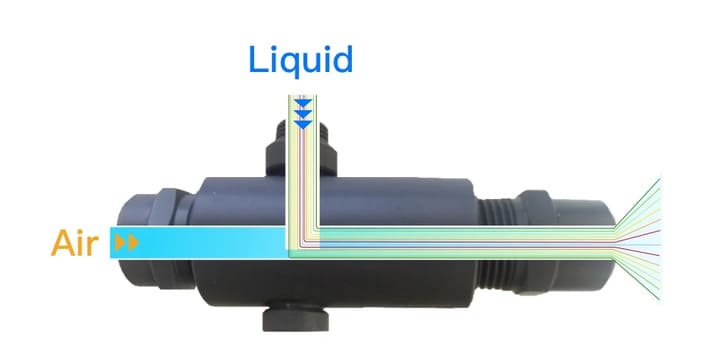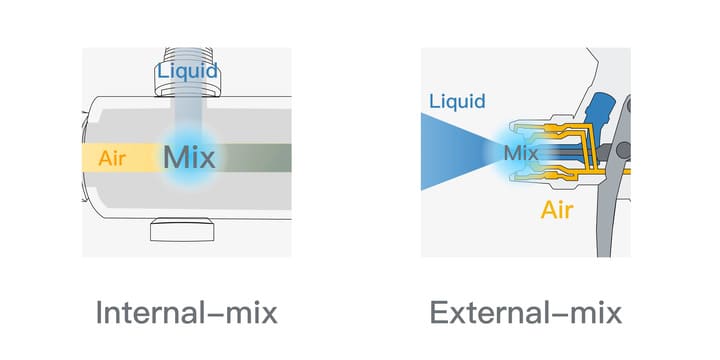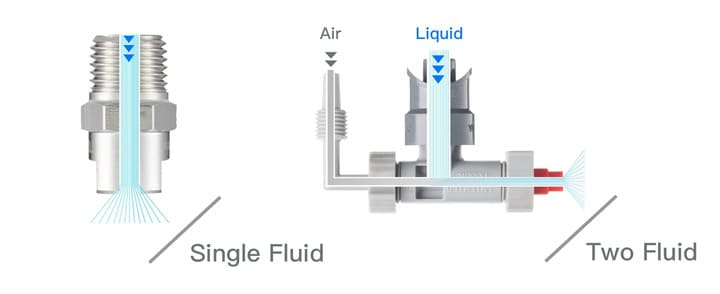ในภาคอุตสาหกรรมและการผลิต หัวฉีดแบบสองของไหลมีความโดดเด่นด้วยการพ่นของเหลวให้เป็นละอองละเอียดโดยการใช้ลมความเร็วสูง ช่วยเพิ่มประสิทธิภาพในการพ่นได้อย่างมาก หัวฉีดเหล่านี้มีทั้งแบบผสมภายในและแบบผสมภายนอก โดยหัวฉีดแบบผสมภายในจะผสมก๊าซและของเหลวภายในหัวฉีด ส่วนแบบผสมภายนอกจะผสมก๊าซและของเหลวนอกหัวฉีด ซึ่งสามารถตอบสนองความต้องการที่หลากหลายและสร้างรูปแบบการพ่นที่แตกต่าง เช่น รูปพัด รูปกรวยตัน และรูปกรวยกลวง
แม้ว่าหัวฉีดแบบสองของไหลจะมีข้อดี เช่น การสร้างละอองที่ละเอียด การทำงานที่แรงดันต่ำ และการกระจายการพ่นที่สม่ำเสมอ แต่ก็ยังมีความท้าทาย เช่น ความซับซ้อนของการออกแบบ ความต้องการแรงดันก๊าซสูง ความเสี่ยงต่อการอุดตัน และต้นทุนที่สูง อย่างไรก็ตาม การใช้งานในกระบวนการที่ต้องการความแม่นยำ เช่น การกัดลาย PCB และการเคลือบผิว แสดงถึงบทบาทสำคัญของหัวฉีดเหล่านี้ในการพัฒนาเทคโนโลยีการผลิต
1. หัวฉีดสองของไหลคืออะไร

หัวฉีดสองของไหลทำงานโดยใช้ลมความเร็วสูงในการกระจายตัวของเหลวให้เป็นละอองละเอียด ช่วยลดขนาดอนุภาคของของเหลว กระบวนการนี้ทำให้สามารถพ่นของเหลวที่มีขนาดอนุภาคเล็กลงและมีอัตราการไหลสูงขึ้น
2. คุณสมบัติของหัวฉีดสองของไหล
- เพิ่มประสิทธิภาพการพ่นละอองของเหลวด้วยการลดขนาดอนุภาคอย่างมีประสิทธิภาพ
- ขยายช่วงการปรับอัตราการไหลของของเหลวด้วยการควบคุมแรงดันก๊าซ
- พ่นด้วยอัตราการไหลสูงและเพิ่มแรงกระแทกได้อย่างมาก
3. หลักการของหัวฉีดสองของไหล
หัวฉีดสองของไหลปฏิวัติการพ่นด้วยการเปลี่ยนของเหลวให้เป็นอนุภาคที่ละเอียดขึ้นด้วยการใช้ลมความเร็วสูง ช่วยเพิ่มประสิทธิภาพการทำความสะอาดและปฏิกิริยาทางเคมีบนพื้นผิว ตัวอย่างเช่น ในกระบวนการกัดลาย PCB หัวฉีดนี้ช่วยให้เกิดปฏิกิริยาที่มีประสิทธิภาพมากขึ้นและครอบคลุมพื้นผิวได้ดีขึ้น ด้วยอนุภาคที่เล็กลง ทำให้ใช้สารเคมีน้อยกว่าหัวฉีดแบบดั้งเดิม
อย่างไรก็ตาม นวัตกรรมนี้มาพร้อมกับข้อพิจารณาบางประการ การผสมของก๊าซและของเหลว โดยเฉพาะในกรณีของสารเคมี อาจเสี่ยงต่อการเกิดออกซิเดชัน ซึ่งอาจลดประสิทธิภาพของสารละลายเร็วกว่าที่คาดไว้ นอกจากนี้ ละอองที่ละเอียดมากอาจทำให้สารละลายบางส่วนหลุดออกไปพร้อมกับก๊าซไอเสีย ส่งผลให้การใช้สารเคมีเพิ่มขึ้นและจำเป็นต้องมีการบำบัดก๊าซไอเสียเพื่อความปลอดภัยด้านสิ่งแวดล้อม
โดยสรุป หัวฉีดสองของไหลให้ความแม่นยำและประสิทธิภาพสูงในการใช้งาน แต่ต้องมีการใช้งานอย่างระมัดระวังเพื่อลดผลกระทบเชิงลบ
[1][2][3][4][5][6][7]
4. วิธีการผสมก๊าซและของเหลวในหัวฉีดสองของไหล
( 1 ) หัวฉีดสองของไหลแบบผสมภายใน
หัวฉีดสองของไหลแบบผสมภายในเป็นหัวฉีดที่ผสมของเหลวและก๊าซภายในหัวฉีด สามารถผลิตอนุภาคของเหลวที่มีขนาดเล็กมาก (โดยมีขนาดอนุภาคเฉลี่ยต่ำกว่า 50µm) และควบคุมขนาดและการกระจายตัวของอนุภาคของเหลวได้ หัวฉีดประเภทนี้ถูกใช้งานอย่างแพร่หลายในอุตสาหกรรม เช่น อุตสาหกรรมเคมี อาหาร ยา และการพิมพ์ ที่ต้องการความแม่นยำและประสิทธิภาพสูง
( 2 ) หัวฉีดสองของไหลแบบผสมภายนอก
หัวฉีดสองของไหลแบบผสมภายนอกเป็นหัวฉีดที่มีคุณสมบัติไม่อุดตัน และสามารถผสมของเหลวกับก๊าซภายนอกหัวฉีดได้ การใช้งานทั่วไปของหัวฉีดประเภทนี้คือปืนพ่นสี ซึ่งเป็นเครื่องมือที่ใช้ในการพ่นสีลงบนพื้นผิว ปืนพ่นสีประกอบด้วยหัวฉีด ถ้วยสี และเครื่องอัดอากาศ เมื่อกดไกปืน สีจะผสมกับกระแสอากาศอัดและถูกพ่นออกมาในรูปแบบละอองละเอียด
( 3 ) ความแตกต่างระหว่างหัวฉีดสองของไหลแบบผสมภายในและผสมภายนอก

หัวฉีดแบบผสมภายในและผสมภายนอกสำหรับของเหลวสองชนิดเป็นที่นิยมในหลากหลายอุตสาหกรรม หัวฉีดทั้งสองชนิดนี้แตกต่างกันในวิธีการผสมระหว่างก๊าซและของเหลว
หัวฉีดแบบผสมภายใน ทำการผสมก๊าซและของเหลวภายในหัวฉีดก่อนที่จะพ่นออกจากช่องทางเดียว หัวฉีดชนิดนี้ใช้งานง่าย ควบคุมได้สะดวก และสามารถพ่นด้วยความแม่นยำและความสม่ำเสมอสูง อย่างไรก็ตาม จำเป็นต้องระวังปัญหาการอุดตันและการทำความสะอาด เนื่องจากกระบวนการผสมเกิดขึ้นภายในหัวฉีด
หัวฉีดแบบผสมภายนอก ทำการผสมก๊าซและของเหลวนอกหัวฉีดก่อนพ่นออกจากช่องทางแยกต่างหาก หัวฉีดชนิดนี้สามารถรองรับอัตราการไหลที่สูงขึ้นและครอบคลุมพื้นที่พ่นที่กว้างกว่า ทำให้เหมาะสำหรับการใช้งานที่เกี่ยวข้องกับการเคลือบที่มีอนุภาคขนาดใหญ่ อย่างไรก็ตาม ควรระวังเรื่องฟองอากาศและการพ่นให้สม่ำเสมอเมื่อใช้งานหัวฉีดแบบผสมภายนอก
การเลือกหัวฉีดสำหรับของเหลวสองชนิดควรพิจารณาตามความต้องการเฉพาะของการใช้งาน หัวฉีดแบบผสมภายในเหมาะสำหรับงานที่ต้องการความแม่นยำและความสม่ำเสมอ ในขณะที่หัวฉีดแบบผสมภายนอกเหมาะกับงานที่ต้องการพื้นที่พ่นที่กว้างและอัตราการไหลที่สูง นอกจากนี้ ควรทำความสะอาดและบำรุงรักษาหัวฉีดอย่างสม่ำเสมอเพื่อให้ได้ประสิทธิภาพสูงสุดและยืดอายุการใช้งาน
[8]
5. รูปแบบการพ่นของหัวฉีดสองของไหล

หัวฉีดสองของไหลสามารถสร้างรูปแบบการพ่นที่หลากหลาย เช่น รูปพัด รูปกรวยตัน และรูปกรวยกลวง โดยทั่วไป หัวฉีดเหล่านี้ถูกออกแบบมาเพื่อให้พ่นเป็นรูปกรวยตันที่มีการกระจายตัวอย่างสม่ำเสมอและมีการทำละอองที่ละเอียด อย่างไรก็ตาม ด้วยการออกแบบโครงสร้างหัวฉีดที่เหมาะสม สามารถสร้างรูปแบบการพ่นเป็นรูปพัดหรือกรวยกลวงได้เช่นกัน
ควรทราบว่าการพ่นของหัวฉีดสองของไหลได้รับผลกระทบจากสภาพแวดล้อมโดยรอบ โดยเฉพาะขนาดอนุภาคที่เล็กของละออง ซึ่งอาจทำให้รูปแบบการพ่นไม่คงที่เมื่อพ่นในระยะที่กำหนด ปัจจัยต่าง ๆ เช่น การเคลื่อนไหวของอากาศ ความชื้น และสภาพแวดล้อมอื่น ๆ อาจส่งผลต่อทิศทางและการกระจายตัวของการพ่น ดังนั้นจึงจำเป็นต้องพิจารณาปัจจัยสิ่งแวดล้อมอย่างละเอียด และปรับพารามิเตอร์การพ่นให้เหมาะสมเพื่อให้ได้รูปแบบและการครอบคลุมที่ต้องการ
6. การระบุหัวฉีดแบบหนึ่งของไหลและสองของไหล

ความแตกต่างหลักระหว่างหัวฉีดแบบหนึ่งของไหลและสองของไหลอยู่ที่โครงสร้างภายในของหัวฉีด หัวฉีดแบบหนึ่งของไหลมีทางเดินเพียงทางเดียว ในขณะที่หัวฉีดแบบสองของไหลมีทางเดินแยกสำหรับก๊าซและของเหลว ความแตกต่างนี้ส่งผลต่อการทำงานและการใช้งานของหัวฉีดแต่ละประเภท
เนื่องจากหัวฉีดสองของไหลต้องการการซีลระหว่างก๊าซและของเหลว หัวฉีดประเภทนี้จึงมักได้รับการออกแบบด้วยส่วนประกอบหลายชิ้น ส่งผลให้ต้นทุนสูงกว่าหัวฉีดแบบหนึ่งของไหล
[9]
7. ข้อดีของหัวฉีดสองของไหล
- สามารถสร้างละอองที่ละเอียดด้วยขนาดอนุภาคเล็กกว่า (ขนาดเฉลี่ยต่ำกว่า 50µm) เมื่อเทียบกับหัวฉีดแบบหนึ่งของไหล และสามารถทำงานได้ที่แรงดันต่ำ (0.1~0.3MPa)
- รับประกันการกระจายตัวของละอองที่สม่ำเสมอและสม่ำเสมอทั่วพื้นที่ที่พ่น
[10]
8. ข้อเสียของหัวฉีดสองของไหล
- การออกแบบที่ซับซ้อน
- ต้องการก๊าซแรงดันสูง
- มีแนวโน้มที่จะอุดตัน
- ต้องการการผลิตที่มีความแม่นยำสูง
- ต้นทุนสูง
- เนื่องจากขนาดอนุภาคของของเหลวที่พ่นมีความละเอียดมาก อาจทำให้เกิดการระเหยได้ง่าย ส่งผลให้อากาศโดยรอบอิ่มตัวไปด้วยอนุภาค เมื่อพ่นของเหลวที่มีฤทธิ์กัดกร่อน จำเป็นต้องมีการแยกพื้นที่อย่างสมบูรณ์ และการระเหยยังทำให้การบริโภคของเหลวเพิ่มขึ้นอย่างหลีกเลี่ยงไม่ได้
9. การประยุกต์ใช้งานหัวฉีดสองของไหล
( 1 ) การกัดลายด้วยหัวฉีดสองของไหล
ในกระบวนการผลิต PCB แบบเปียก สำหรับการกัดลายร่องแคบที่มีขนาดต่ำกว่า 25μm หัวฉีดสองของไหลถูกใช้เพื่อส่งสารเคมีเข้าสู่ช่องว่างขนาดเล็ก โดยหัวฉีดเหล่านี้ใช้ลมความเร็วสูงในการสร้างละอองที่เล็กลงและมีความเร็วในการไหลสูงขึ้น ทำให้มั่นใจได้ว่าการพ่นสารมีความสม่ำเสมอและมีประสิทธิภาพ ดังนั้นหัวฉีดสองของไหลจึงเป็นที่นิยมในกระบวนการ PCB เฉพาะทาง
( 2 ) การเพิ่มประสิทธิภาพการบำบัดก๊าซไอเสียด้วยหัวฉีดสองของไหล
ด้วยข้อได้เปรียบของขนาดละอองที่เล็ก หัวฉีดสองของไหลถูกใช้งานอย่างกว้างขวางในการบำบัดก๊าซไอเสีย โดยเฉพาะในการจัดการปัญหาละออง PM2.5

( 3 ) การทำความสะอาดด้วยหัวฉีดสองของไหล
ในการทำความสะอาด การใช้เครื่องมือแรงดันสูงมักมีต้นทุนสูง หัวฉีดสองของไหลจึงถูกนำมาใช้เพื่อลดต้นทุน เนื่องจากสามารถสร้างความเร็วการพ่นสูงโดยไม่ต้องใช้แรงดันสูง ตัวอย่างคือการใช้หัวฉีดสองของไหลในอุตสาหกรรมการพิมพ์เพื่อทำความสะอาดหมึกในเครื่องล้างหน้าจอ
( 4 ) การประยุกต์ใช้งานอื่น ๆ ของหัวฉีดสองของไหล
หัวฉีดที่มีความหลากหลายนี้ถูกนำไปใช้ในงานต่าง ๆ เช่น การควบคุมควัน การพ่นสี การเพิ่มความชื้น การหล่อลื่น การทำความเย็น/ปรับสภาพก๊าซ และการทำละออง
[11][12][13]